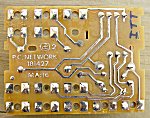Western Electric Products - Technical - Networks**
Sewing Machine - Automatic Answering Service “Mirrophone” wire ribbon recorder/player Telephones - PicturePhone - Bell Chime
If you’ve ever opened up an old telephone made back in the days when phones were built to last for decades you may have notice a little metal box with a plastic top. The plastic top has a bunch of screw terminals with wires coming from the screw terminals to various parts of the telephone like the dial and bell ringer coil. Well, that metal box with all those screw terminals is what is known as the telephone’s network circuitry. It contains resistors, varistors, coils and other passive electronic components that interconnect all of the other parts of the telephone with your telephone line cord. It actually does a lot more than just provide a centralized location for hooking up all of those pretty colored wires in the phone, it provides impedance matching, side-tone, d.c. current blocking for the bell ringer coil, suppression of voltage spikes, and other functions.
Although all models of these networks were functionally very similar, some networks were designed to be smaller than their predecessors in order to fit into the newer telephones like the Princess and the 2554 wall phone and the Trimline model desk and wall phone. Others had special radio interference suppression circuitry built into the network to block or greatly reduce interference from nearby radio or TV stations or ham radio operators.
Schematics for these various networks were not published for all models by Western Electric - at least not in the Bell System Practices manuals I’ve seen. ITT, however, did publish schematics of the various networks in their copycat telephones made under license from Western Electric (AT&T). See the ITT service manual web page (not on this website) for schematics of these networks plus the Western Electric Telephones web page for more schematics.

We Offer Personalized One-On-One Service!
Call Us Today at (651) 787-DIAL (3425)


Line and Ringer Connections Look-up Table For 4228 Network
To help you identify some of these networks I took some photos with my Sony 5 mega-pixel camera of various networks I have accumulated which you can view by clicking on the links below:
4228 Network (top and side view) 4228 Network (bottom view)
Side-by-side comparison digital ** **photograph of two types of 425 networks
Individual photos of a 425G network and 425K network.
Some networks were modified for RFI (Radio Frequency Interference) suppression. Here are schematics of three such networks:
Here are a couple of photos of a cheap ITT network. Note the exposed parts and circuit paths. These circuits will not withstand humid environments or contaminants as well as the Western Electric counterparts.



Reliable, secure high-speed internet
With CenturyLink Simply Unlimited Internet, you can choose from a wide range of available speeds that fit your online needs. Plus, you can connect several devices with super-fast in-home WiFi.
Order Now



